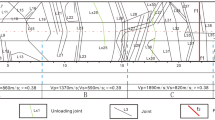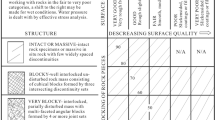Abstract
Traditional measurements of block size (or degree of jointing), such as the rock quality designation (RQD), are questionable due to certain theoretical limitations, including orientation bias and their weakness in considering the joint persistence and three-dimensional shapes of block sizes. This may lead to inaccurate characterizations of rock mass structures and unreliable classification of rock mass qualities. The modified blockiness index (MBi) is a three-dimensional measurement of block size which was developed to overcome these problems. In this study, correlations between MBi and several traditional block size measurements were assessed; based on the MBi, the rock mass rating (RMR) system was modified, and this version was termed RMRmbi. In the first part of this work, multiple simulated experiments were conducted using the GeneralBlock software program and 3DEC (three-dimensional distinct element code), and a large volume of MBi, RQD, joint frequency (JF) and volumetric joint count (Jv) values (artificial data sets) were obtained; subsequently, the correlations between MBi and RQD, JF and Jv were assessed. In the second part, the combined use of RQD and JF in the RMR system was replaced with MBi, and hence, the RMRmbi system was developed; based on the artificial data sets, the viability of RMRmbi was preliminarily supported. At the end of this study, the correlations between MBi and RQD, JF and Jv were verified based on actual data; the RMRmbi was applied to real cases, and a comparison between RMRmbi and RMR was conducted. The results showed that (i) the MBi can capture the influence of joint persistence; (ii) the RMRmbi system can overcome the theoretical limitations caused by RQD and JF; and (iii) simulated experiments showed that the RMRmbi values are more reliable, thus validating the accuracy of RMRmbi and revealing its great potential for future application.


































Similar content being viewed by others
Abbreviations
- 3DEC:
-
Three-dimensional distinct element code
- 3DJN :
-
Three-dimensional joint network model
- A :
-
Rotation matrix
- COV :
-
Coefficient of variation
- d 3 :
-
Three-dimensional joint density
- JF :
-
Joint frequency
- JN :
-
Joint set number
- JO :
-
Joint orientation
- JP :
-
Joint persistence
- JS :
-
Joint spacing
- J v :
-
Volumetric joint count
- MAPE:
-
Mean absolute percentage error
- MB i :
-
Modified blockiness index
- REV:
-
Representative elementary volume
- R M :
-
The rating of MBi in the RMRmbi system
- RMR :
-
Rock mass rating system
- RMR mbi :
-
A modified RMR system based on the MBi
- RMSE:
-
Root-mean-square error
- RQD :
-
Rock quality designation
- R RQD+JF :
-
The ratings of RQD plus JF in the RMR system
- VIF:
-
Variance inflation factor
References
Aksoy CO (2008) Review of rock mass rating classification: historical developments, applications, and restrictions. J Min Sci 44:51–63. https://doi.org/10.1007/s10913-008-0005-2
Aydan Ö, Ulusay R, Tokashiki N (2014) A new rock mass quality rating system: rock mass quality rating (RMQR) and its application to the estimation of geomechanical. Rock Mech Rock Eng 47:1255–1276. https://doi.org/10.1007/s00603-013-0462-z
Barton N, Lien R, Lunde J (1974) Engineering classification of rock masses for the design of tunnel support. Rock Mech Felsmechanik Mécanique des Roches 6:189–236. https://doi.org/10.1007/BF01239496
Bejari H, Khademi Hamidi J (2013) Simultaneous effects of joint spacing and orientation on TBM cutting efficiency in jointed rock masses. Rock Mech Rock Eng 46:897–907. https://doi.org/10.1007/s00603-012-0314-2
Bieniawski ZT (1989) Geomechanics classification: engineering rock mass classifications. Wiley, New York
Buyer A, Schubert W (2017) Calculation the spacing of discontinuities from 3D point clouds. Procedia Eng 191:270–278. https://doi.org/10.1016/j.proeng.2017.05.181
Celada B, Tardáguila I, Varona P, Bieniawski ZT (2014) Innovating tunnel design by an improved experience-based RMR system. In: Proceedings of the World Tunnel Congress 2014 – Tunnels for a better Life. Foz do Iguaçu, Brazil, vol 3, pp 1–9
Central South University, Huaxi Group, Liuzhou Huaxi Nonferrous Designing Institute (2011) Assessment of the engineering rock mass quality in Xintongkuang mine (a concluding report)
Chen Q, Niu W, Zheng W et al (2018) Correction of some problems in blockiness evaluation method in fractured rock mass. Rock Soil Mech 39(10):3727–3734 (in Chinese with English abstract)
Chen Q, Yin T, Jia H (2019) Selection of optimal threshold of generalised rock quality designation based on modified blockiness index. Advances in Civil Engineering 2019:1340549
Deere DU, Hendron AJ, Patton FD et al (1967) Design of Surface and Near-Surface Construction in rock. In: Fairhurst C (ed) Failure and breakage of rock. Society of Mining Engineers of AIME, New York, pp 237–302
Dershowitz W, Doe T, Uchida M et al (2003) Correlations between fracture size, transmissivity, and aperture. Soil and rock America. In: Proceedings of the 12th Panamerican Conference on Soil Mechanics and Geotechnical Engineering, 39th US Rock Mechanics Symposium, Cambridge, 22-26 June, pp 887–891
Feng X, Jimenez R (2015) Estimation of deformation modulus of rock masses based on Bayesian model selection and Bayesian updating approach. Eng Geol 199:19–27. https://doi.org/10.1016/j.enggeo.2015.10.002
Grenon M, Hadjigeorgiou J (2003) Evaluating discontinuity network characterization tools through mining case studies. Soil Rock America 2003, Boston, 1, 137–142
Guangxi University, Huaxi Group (2013) Classification for the jointed rock masses and optimization of the mining technology in Tongkeng mine (a concluding report)
Harrison JP (1999) Selection of the threshold value in RQD assessments. Int J Rock Mech Min Sci 36:673–685
Hoek E, Diederichs MS (2013) Quantification of the geological strength index chart. Presented at the 47th US Rock Mechanics/Geomechanics Symposium, ARMA 13-672, San Francisco CA, June 23-26, 2013
ISRM (1978) Suggested methods for the quantitative description of discontinuities in rock masses. Int J Rock Mech Min Sci Geomech Abstr 15:319–368. https://doi.org/10.1016/0148-9062(79)91476-1
Itasca (2013) 3DEC: three-dimensional distinct element code. Ver. 5.0. Itasca Consulting Group Inc, Minneapolis
Kim BH, Cai M, Kaiser PK, Yang HS (2007) Estimation of block sizes for rock masses with non-persistent joints. Rock Mech Rock Eng 40:169–192. https://doi.org/10.1007/s00603-006-0093-8
Koutsoftas DC (2017) Discussion of “rock quality designation (RQD): time to rest in peace”. Can Geotech J 55:584–592. https://doi.org/10.1139/cgj-2017-0497
Li Y, Wang Q, Chen J et al (2014) Determination of structural domain boundaries in jointed rock masses: an example from the Songta dam site, China. J Struct Geol 69:179–188
Lin F (2008) Evaluation of in-situ measurement methods for counting volumetric joints of rock mass. J Eng Geol 16:663–666 (in Chinese with English abstract)
Liu Q, Liu J, Pan Y et al (2017) A case study of TBM performance prediction using a Chinese rock mass classification system – hydropower classification (HC) method. Tunn Undergr Sp Technol 65:140–154. https://doi.org/10.1016/j.tust.2017.03.002
Martin MW, Tannant DD (2004) A technique for identifying structural domain boundaries at the EKATI diamond mine. Eng Geol 74:247–264. https://doi.org/10.1016/j.enggeo.2004.04.001
Miller SM (1983) A statistical method to evaluate homogeneity of structural populations. Math Geol 15:317–328
Palmstrom A (1982) The volumetric joint count: a useful and simple measure of the degree of rock mass jointing. Proc 4th Congr Int Assoc, Engng Geol, vol 2, pp 221–228
Palmstrom A (1996) Characterizing rock masses by the RMi for use in practical rock engineering: part 1: the development of the rock mass index (RMi). Tunn Undergr Sp Technol 11:175–188. https://doi.org/10.1016/0886-7798(96)00015-6
Palmstrom A (2005) Measurements of and correlations between block size and rock quality designation (RQD). Tunn Undergr Sp Technol 20:362–377. https://doi.org/10.1016/j.tust.2005.01.005
Pan H (2012) Research on grouting uplifting mechanism of plinth of concrete facing dam. Xihua University, Chengdu
Pells PJ, Bieniawski ZT, Hencher SR, Pells SE (2017) Rock quality designation (RQD): time to rest in peace. Can Geotech J 54:825–834. https://doi.org/10.1139/cgj-2016-0012
PRC Ministry of Construction (1995) Standard for engineering classification of rock masses. China planning press, China (in Chinese)
Priest SD, Hudson JA (1976) Discontinuity spacings in rock. Int J Rock Mech Min Sci 13:135–148. https://doi.org/10.1016/0148-9062(76)90818-4
Riquelme AJ, Abellán A, Tomás R (2015) Discontinuity spacing analysis in rock masses using 3D point clouds. Eng Geol 195:185–195. https://doi.org/10.1016/j.enggeo.2015.06.009
Riquelme AJ, Tomás R, Abellán A (2016) Characterization of rock slopes through slope mass rating using 3D point clouds. Int J Rock Mech Min Sci 84:165–176. https://doi.org/10.1016/j.ijrmms.2015.12.008
Shang J, West LJ, Hencher SR, Zhao Z (2018) Geological discontinuity persistence: implications and quantification. Eng Geol 241:41–54. https://doi.org/10.1016/j.enggeo.2018.05.010
Terzaghi RD (1965) Sources of error in joint surveys. Géotechnique 15:287–304. https://doi.org/10.1680/geot.1965.15.3.287
Wang X (2011) Analysis and simulation of fractured character in layer rockmass based on probabilistic: a case study of the dam of Jinping I hydropower station. China University of Geoscience, Wuhan
Wang C, Hu P, Sun W (2010) Method for evaluating rock mass integrity based on borehole camera technology. Rock Soil Mech 31:1326–1330. (in Chinese with English abstract). https://doi.org/10.16285/j.rsm.2010.04.008
Warren SN, Kallu RR, Barnard CK (2016) Correlation of the rock mass rating (RMR) system with the unified soil classification system (USCS): introduction of the weak rock mass rating system (W-RMR). Rock Mech Rock Eng 49:4507–4518. https://doi.org/10.1007/s00603-016-1090-1
Wong LNY, Lai VSK, Tam TPY (2018) Joint spacing distribution of granites in Hong Kong. Eng Geol 245:120–129. https://doi.org/10.1016/j.enggeo.2018.08.009
Xia L, Li M, Chen Y et al (2015) Blockiness level of rock mass around underground powerhouse of three gorges project. Tunn Undergr Sp Technol 48:67–76. https://doi.org/10.1016/j.tust.2015.02.002
Xia L, Zheng Y, Yu Q (2016) Estimation of the REV size for blockiness of fractured rock masses. Comput Geotech 76:83–92. https://doi.org/10.1016/j.compgeo.2016.02.016
Yarahmadi R, Bagherpour R, Taherian SG, Sousa LMO (2018) Discontinuity modelling and rock block geometry identification to optimize production in dimension stone quarries. Eng Geol 232:22–33. https://doi.org/10.1016/j.enggeo.2017.11.006
Zhang L (2016) Determination and applications of rock quality designation (RQD). J Rock Mech Geotech Eng 8:389–397. https://doi.org/10.1016/j.jrmge.2015.11.008
Zhang Q, Bian Z, Yu M (2009) Preliminary research on rockmass integrity using spatial block identification technique. Yanshilixue Yu Gongcheng Xuebao/Chinese J Rock Mech Eng 28(3):507–515 (in Chinese with English abstract)
Zhang W, Wang Q, Chen J et al (2012) Determination of the optimal threshold and length measurements for RQD calculations. Int J Rock Mech Min Sci 51:1–12
Zhang W, Chen J, Cao Z, Wang R (2013) Size effect of RQD and generalized representative volume elements: a case study on an underground excavation in Baihetan dam, Southwest China. Tunn Undergr Sp Technol 35:89–98. https://doi.org/10.1016/j.tust.2012.12.007
Zheng J, Deng J, Yang X et al (2014) An improved Monte Carlo simulation method for discontinuity orientations based on fisher distribution and its program implementation. Comput Geotech 61:266–276
Zheng J, Yang X, Lü Q et al (2018) A new perspective for the directivity of rock quality designation (RQD) and an anisotropy index of jointing degree for rock masses. Eng Geol 240:81–94. https://doi.org/10.1016/j.enggeo.2018.04.013
Acknowledgements
This work was funded by the National Key R&D Program of China (no. 2018YFC0808402).
Author information
Authors and Affiliations
Corresponding author
Ethics declarations
Conflict of interest
The authors declare no conflict of interest.
Rights and permissions
About this article
Cite this article
Chen, Q., Yin, T. Modification of the rock mass rating system (RMRmbi) considering three-dimensional rock block size. Bull Eng Geol Environ 79, 789–810 (2020). https://doi.org/10.1007/s10064-019-01596-x
Received:
Accepted:
Published:
Issue Date:
DOI: https://doi.org/10.1007/s10064-019-01596-x




